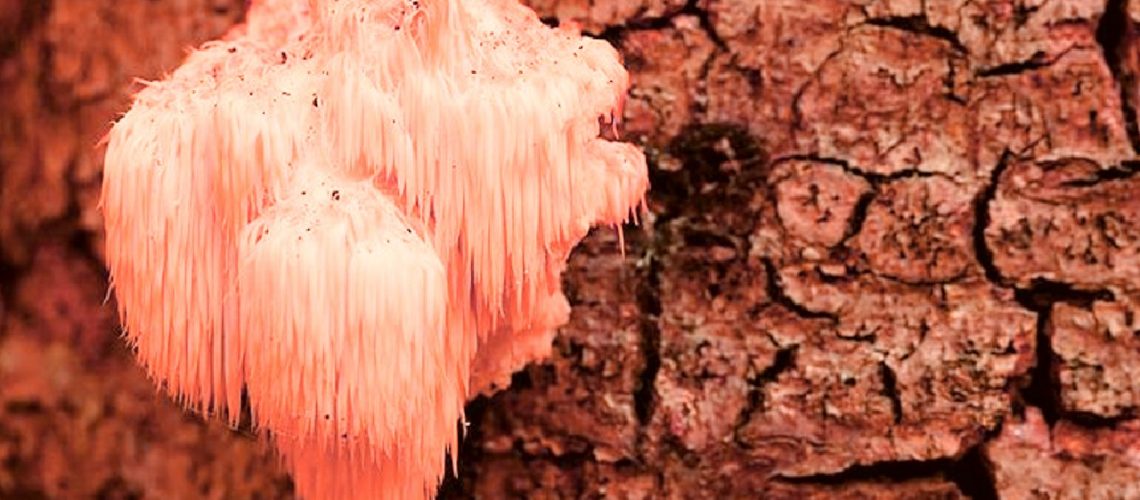

Astrodose
All About The Lion’s Mane Mushroom
- ,
- , benefits
Mushrooms are hot, hot property — despite themselves preferring it damp and gloomy. And it’s not just the magic ones. In trendy cafes you can sup on an earthy mushroom latte, your local health food store is stocking all kinds of supplements and teas, and even the button mushrooms in your local supermarket have a glow about them…
OK perhaps we exaggerate, but you get the idea. Mushroom mania. While we are devotees of the psilocybin mushroom, where we get our microdose-able magic truffles from (they are the underground portion of the fungus.) We are also avid fans of other types of medicinal mushrooms!

Today we will explore a mushroom you may have heard of, one of the stars of the medicinal mushroom revolution. (At least in the West… Eastern medicine has of course known the incredible properties of mushrooms for millenia.) It is the Lion’s Mane Mushroom — hear it roar!
What Is Lion’s Mane Mushroom?
Lion’s Mane mushroom (Hericium erinaceus) is a medicinal mushroom that has been known for centuries to benefit everything from brain to mood. In fact, such are its brain boosting capabilities, it is counted as a ‘nootropic‘, which basically translates to ‘smart drug’. Also included under the nootropic banner are other naturally occurring substances such as caffeine, and synthetic drugs like Adderall.
What Does It Look Like?
Native to Southeast Asia, Europe and North America, it grows hanging off trees and logs. It is known in Japan as yamabushitake which means ‘those who sleep in the mountains’. This is in reference to Shugendo monks who wear long flowing white robes. Elsewhere however, it takes its name from the ‘King of the Jungle’ (Is nobody aware lions actually live on the savanna?!) due to its shaggy appearance. A bit like a lost anemone growing on land, it definitely doesn’t resemble the cute ‘lil toadstool you’re used to.

So now we know it looks freaky. But what can it do?
Powers and Supports the Brain
As you age, your brain naturally becomes slower. The stereotype of becoming forgetful as you get older, is due to the very real process of neurons shrinking and cells becoming damaged over time. However! Studies have shown that Lion’s Mane combats this problem from two different angles. Firstly, Lion’s Mane stimulates Nerve Growth Factor (NGF) which is required by your body to protect and regenerate brain neurons.

Secondly, it also stimulates the production of Brain-Derived Nuerotrophic Factor (BDNF) which as well as helping to strengthen neurons, improves brain plasticity, combatting the effects of aging. In the past it was thought that you were stuck with the amount of brain cells you had from childhood onwards. Through the research into Lion’s Mane it is becoming apparent that (luckily) this may not be the case!
Combats Neurodegenerative Disease
These brain regenerative abilities (described above) make Lion’s Mane a key possibility for the treatment of neurodegenerative diseases such as Alzheimer’s and Parkinson’s. Studies on rodents have indicated that Lion’s Mane extract can protect against memory loss and involuntary movement — both effects of Alzheimer’s and Parkinson’s. An early human study (double-blind and placebo controlled) on a group of 15 older people found that Lion’s Mane successfully improved cognitive function.
Improved Mood and Focus
Studies have shown that Lion’s Mane extract can improve mood. In both animal and initial human studies, depressive symptoms were found to be reduced when the extract was taken. This could be due to Lion’s Mane’s anti inflammatory qualities. Chronic inflammation has been found to be one of the contributing factors to mood disorders such as depression and anxiety. Reduced inflammation also increases blood flow to the brain, thus improving overall function.
There is also a wealth of anecdotal evidence from Lion’s Mane users of its effects. On message boards such as Reddit, users report improved focus and a reduction of ‘brain fog’. This ability to think more clearly, as well as improved memory and decision making skills, is most likely due to Lion’s Mane’s ability to enhance neuroplasticity.
The Paul Stamets Microdosing Stack
Lion’s Mane has also come under the spotlight recently, due to its inclusion in the Paul Stamets Microdosing Stack. (‘The who, what, why?’ you may ask…) Paul Stamets is an American Mycologist who features in the recent movie ‘Fantastic Fungi’. An expert, as well as a passionate advocate of mushrooms, he devised his own microdosing system that he believes is the key to improved cognitive function and the winning the fight against neurodegenerative disease.

The ‘stack’ or ‘protocol’ consists of 3 components:
- Lion’s Mane Mushroom Extract— for its neuron and cell regeneration capabilities.
- Psilocybin — the psychoactive compound of magic truffles, known to make new neural connections and increase brain plasticity.
- Niacin— (that’s vitamin B3 to you and me!) which works to send the compounds to the furthest reaches of the body.
How To Take Lion’s Mane
Lion’s Mane mushroom is, unlike quite a lot of medicinal mushrooms, actually edible. It can be cooked, dried, eaten raw or steeped in tea. The flavour is apparently seafood-esque and can be enjoyable. However, if you don’t want a shrimp flavour cuppa, it is easy to get hold of as a supplement or tincture. However, it is always good to research the product before buying to check the active compound to filler ratio.
We hope this has taught you all you need to know about this shaggy shroom. And, as always, we recommend you consult your doctor before making any changes to your health routine.










